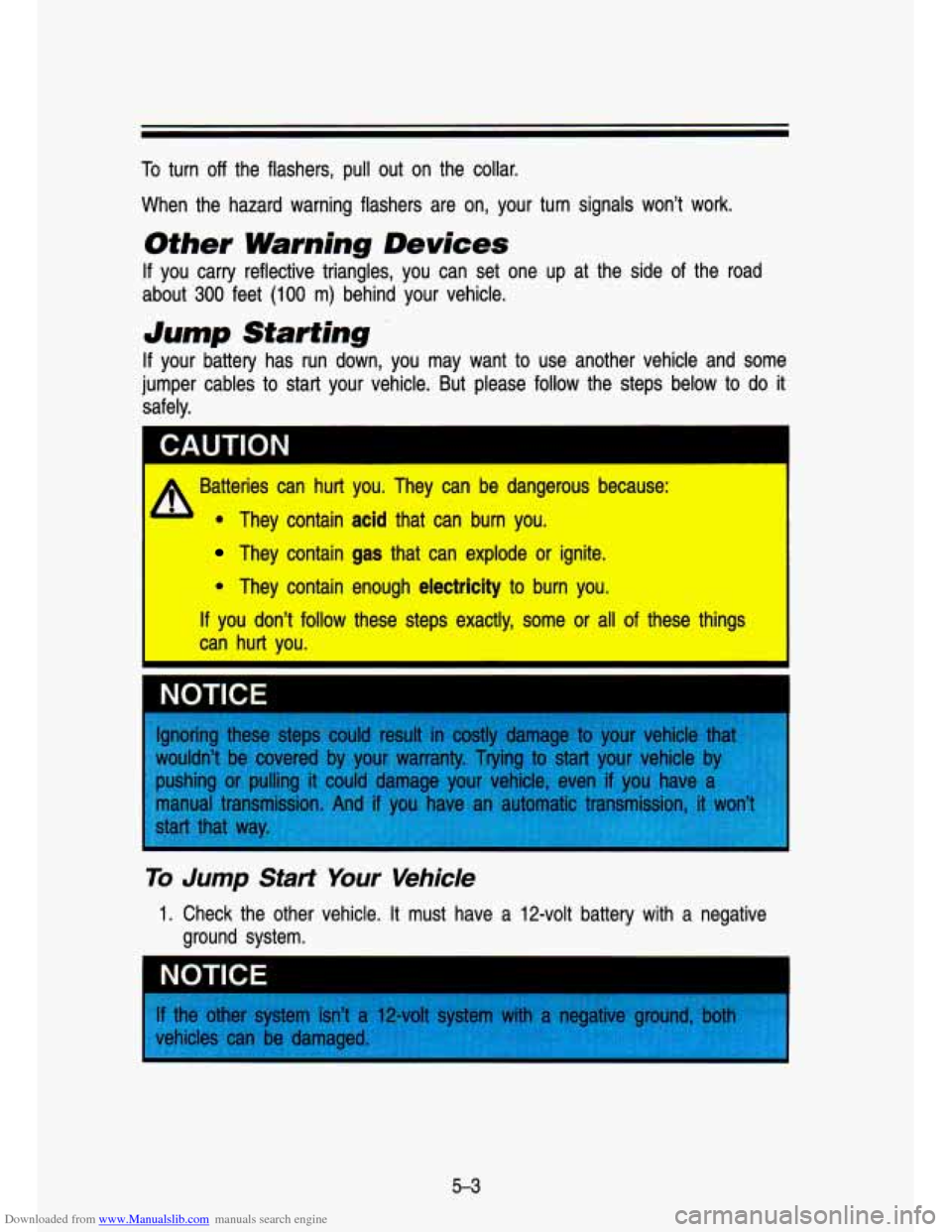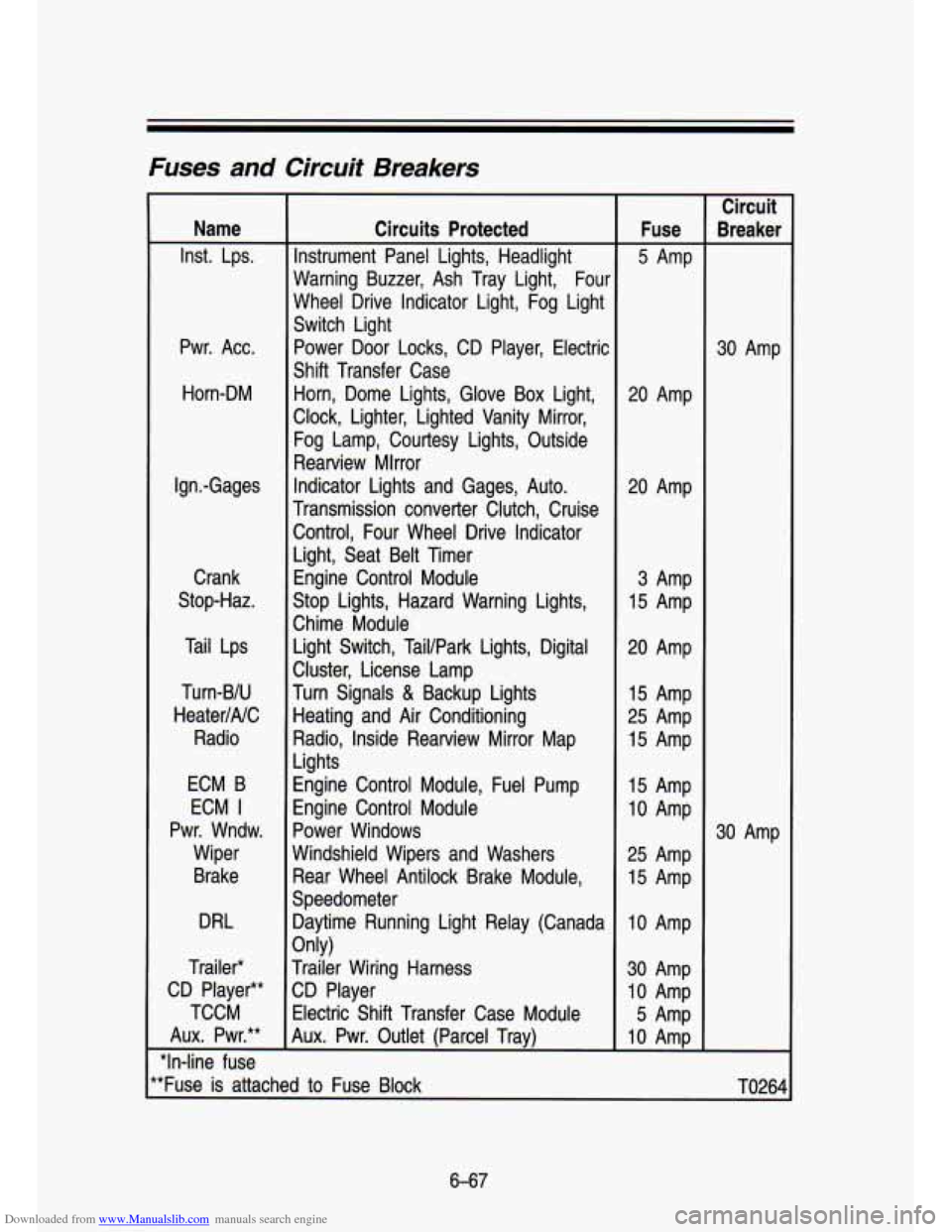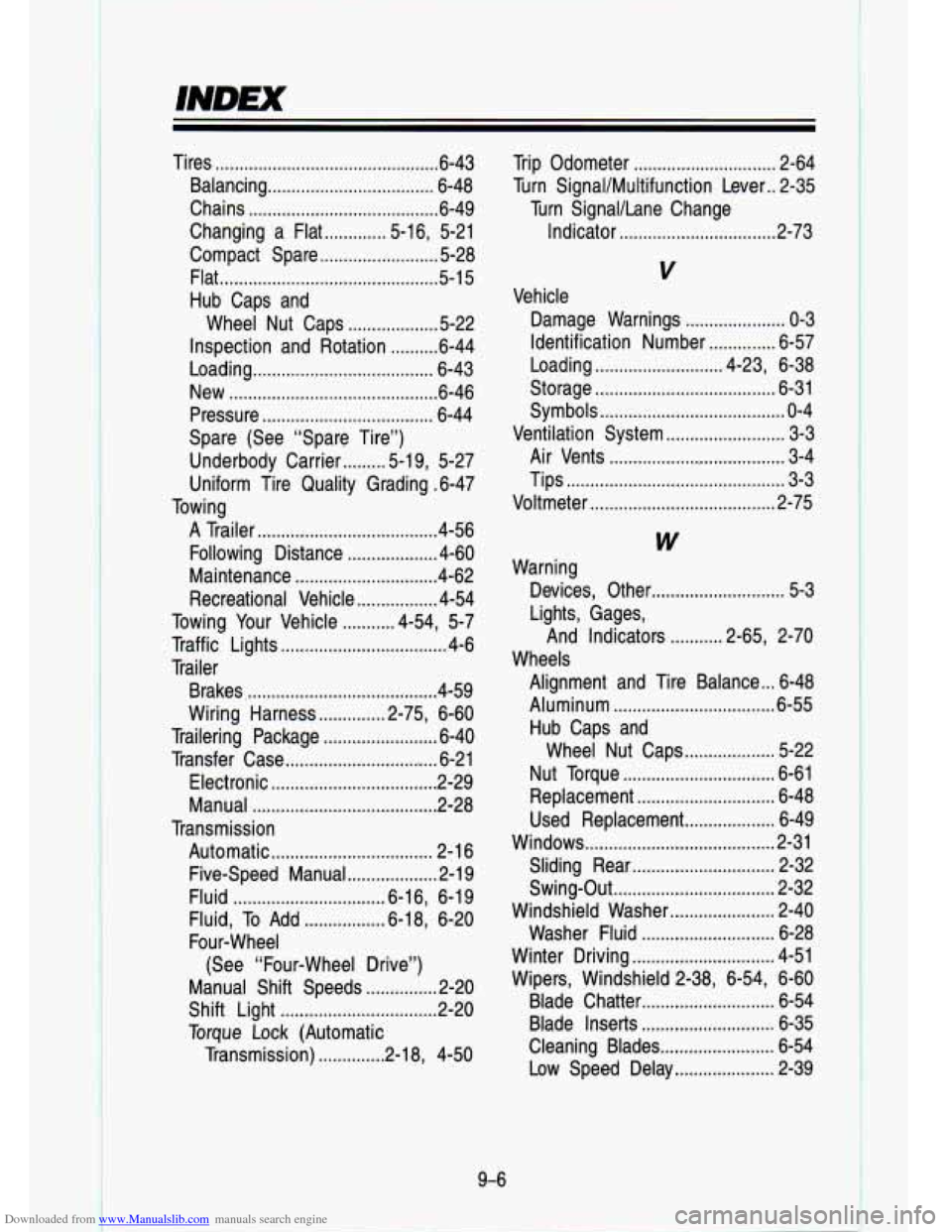1993 CHEVROLET S10 turn signal
[x] Cancel search: turn signalPage 199 of 356

Downloaded from www.Manualslib.com manuals search engine On the Road
Unless you are the only driver, it is good to share the driving task with
others. Limit turns behind the wheel to about
100 miles (160 km) or two
hours at a sitting. Then, either change drivers or stop for s\
ome refreshment
like coffee, tea or soft drinks and some limbering up. But
do stop and move
around. Eat lightly along the way. Heavier meals tend to make some people
sleepy.
On two-lane highways or undivided multilane highways that
do not have
controlled access, you’ll want to watch for some situations not usually found
on freeways. Examples are: stop signs and signals, shopping cen\
ters with
direct access to the highway, no passing zones and school zones, vehicles
turning left and right
off the road, pedestrians, cyclists, parked vehicles, and
even animals.
Highway Hypnosrs
Is there actually such a condition as “highway hypnosis?” Or \
is it just plain
falling asleep at the wheel? Call it highway hypnosis, lack of awareness, or
whatever.
There is something about an easy stretch of road with the same scenery,
along with the hum of the tires on the road, the drone of the engine, and the
rush of the wind against the vehicle that can make you sleepy. Don’\
t let it
happen to you!
If it does, your vehicle can leave the road in less than a
second, and you could crash and be injured.
What can you
do about highway hypnosis? First, be aware that it can
happen.
Then here are some tips:
Make sure your vehicle is well ventilated, with a comfortably \
cool interior.
Keep your eyes moving. Scan the road ahead and to the sides. \
Check
your rearview mirrors frequently and your instruments from time \
to time.
This can help you avoid a fixed stare.
Wear good sunglasses in bright light. Glare can cause drowsines\
s. But don’t wear sunglasses at night. They will drastically reduce \
your overall
vision at the very time you need all the seeing power you have.
If you get sleepy, pull off the road into a rest, service, or parking area
and take a nap, get some exercise, or both. For safety, treat drowsiness
on the highway as an emergency.
As in any driving situation, keep pace with traffic and allow adequat\
e
following distances.
4-45
Page 214 of 356

Downloaded from www.Manualslib.com manuals search engine Your Driving and the Road
Following Distance
Stay at least twice as far behind the vehicle ahead as you w\
ould when
driving your vehicle without a trailer. This can help you avoi\
d situations that require heavy braking and sudden turns.
Passing
You’ll need more passing distance up ahead when you’re to\
wing a trailer.
And, because you’re a good deal longer, you’ll need
to go much farther
beyond the passed vehicle before you can return
to your lane.
Backing Up
Hold the bottom of the steering wheel with one hand. Then, to move the
trailer left, just move your hand to the left. To move the trailer to the right,
move your hand
to the right. Always back up slowly and, if possible, have
someone guide you.
Making Turns
When you’re turning with a trailer, make wider turns than n\
ormal. Do this so
your trailer wheels won’t strike soft shoulders, curbs, road \
signs, trees, or
other objects. Avoid jerky or sudden maneuvers. Signal well in advance.
Turn Signals When Towing a Trailer
When you tow a trailer, your vehicle has to have a different turn signal
flasher and extra wiring. The green arrows on your instrument \
panel will flash
whenever you signal a turn or lane change. Properly hooked up,\
the trailer lights will also flash, telling other drivers you’re about
to turn, change lanes,
or stop.
When towing a trailer, the green arrows on your instrument pan\
el will flash for
turns even
if the bulbs on the trailer are burned out. Thus, you may think \
drivers behind you are seeing your signal when they are not.
It’s important to
check occasionally to be sure the trailer bulbs are still work\
ing.
Driving on Grades
Reduce speed and shift to a lower gear before you start down a long or
steep downgrade.
If you don’t shift down, you might have to use your brakes
so much that they would get hot and no longer work well.
On a long uphill grade, shift down and reduce your speed to \
around
45 mph
(70 km/h) to reduce the possibility of engine and transmission ove\
rheating.
If you have an automatic transmission, you should use D when towing a
trailer. Operating your vehicle in
D when towing a trailer will minimize heat
buildup and extend the life of your transmission. Or, if you have a manual
transmission with fifth gear, it’s better not to use fifth \
gear, just drive in fourth
gear (or, as you need
to, a lower gear).
4-60
Page 218 of 356

Downloaded from www.Manualslib.com manuals search engine Problems on the Road
AM505003
Your hazard warning flashers let you warn others. They also let pol\
ice know
you have a problem. Your front and rear turn signal lights will flash on and
off. But they won’t flash if you’re braking.
i
Press the button in to make your front and rear turn signal lights flash on
and
off.
Your hazard warning flashers work no matter what position your key is in,
and even if the key isn’t in.
Page 219 of 356

Downloaded from www.Manualslib.com manuals search engine To turn off the flashers, pull out on the collar.
When the hazard warning flashers are on, your turn signals won\
’t work.
Other Warning Devices
If you carry reflective triangles, you can set one up at the sid\
e of the road
about
300 feet (100 m) behind your vehicle.
Jump Starting
If your battery has run down, you may want to use another vehicle and some
jumper cables to start your vehicle. But please follow the ste\
ps below to
do it
safely.
mwlmm A
A Batteries cart hurt you. They m be dangerous because:
* They contain acid that can burn you.
They contain gas that can explode or ignite.
* They contain enough electricity to burn you.
I
If you don’t follow these steps exactly, some 01: all .of thlese things
can hurt
yoW.
To Jump Start Your Vehicle
1. Check the other vehicle. It must have a 12-volt battery with ti negative
ground system.
IWU I IWL I
5-3
Page 280 of 356

Downloaded from www.Manualslib.com manuals search engine Service & Appearance Care
Headlights
KO993
1. Remove the four screws from the headlight retainer.
2. Pull the headlight out and remove the retainer.
3. Unplug the headlight.
4. Plug in the new bulb and put it in place.
5. Install the retainer to the headlight.
6. Install the screws.
Front ParkingfTurn Signal Lights
KO663
1. Reach under and behind the parkingkurn signal light assembly.
6-32
i
Page 312 of 356

Downloaded from www.Manualslib.com manuals search engine Service & Appearance Cam
Lamp And Bulb Data
Exterior Lamps
Check Gages Indicator' Daytime Running Lights Indicator'
Daytime Running Lights Indicator2
..-
Charging System Indicator' High Beam Indicator'
High Beam lndicato?
I
Quantity 1 1
Trade No.
PC1 94
PC1 74
PC1 94
-
Instrument Cluster Illumination' 6 3 PC1 68
Malfunction Indicator Lamp (Service Engine 1 .7 PC74
Soon)'
Malfunction Indicator Lamp (Service Engine
Soon)'
I I pc194
Seat Belt Indicator'" 1 2 PC1 94
Shift Indicator (PRNDL)'
1 2 PC1 94
Tachometer Warning Band'
1 2 PC1 94
Turn Signal Indicator'
2 .7 PC74
Upshift Indicator' 1 .7 PC74
Upshift Indicator2 1
2 PC1 94
'With Standard Instrument Cluster 'With Digital Instrument Cluster
6-64
Page 315 of 356

Downloaded from www.Manualslib.com manuals search engine Fuses and Circuit Breakers
Name
Inst. Lps.
Pwr. Acc. Horn-DM
Ign.-Gages Crank
Stop-Haz.
Tail Lps
Turn-BIU
HeaterINC Radio
ECM B
ECM
I
Pwr. Wndw. Wiper
Brake
DRL
Trailer*
CD Player**
TCCM
Aux. Pwr.**
"In-line fuse Circuits Protected
Instrument Panel Lights, Headlight
Warning Buzzer, Ash Tray Light, Four
Wheel Drive Indicator Light, Fog Light
Switch Light Power Door Locks, CD Player, Electric
Shift Transfer Case Horn, Dome Lights, Glove Box Light,
Clock, Lighter, Lighted Vanity Mirror,
Fog Lamp, Courtesy Lights, Outside
Rearview Mlrror
Indicator Lights and Gages, Auto.
Transmission converter Clutch, Cruise Control, Four Wheel Drive Indicator
Light, Seat Belt Timer Engine Control Module
Stop Lights, Hazard Warning Lights,
Chime Module Light Switch, Tail/Park Lights, Digital
Cluster, License Lamp
Turn Signals
& Backup Lights
Heating and Air Conditioning
Radio, Inside Rearview Mirror Map
Lights
Engine Control Module, Fuel Pump
Engine Control Module
Power Windows
Windshield Wipers and Washers Rear Wheel Antilock Brake Module,
Speedometer Daytime Running Light Relay (Canada
Trailer Wiring Harness
CD Player
Electric Shift Transfer Case Module
Aux. Pwr. Outlet (Parcel Trav)
Only) Fuse
5 Amp
20 Amp
20 Amp
3 Amp
15 Amp
20 Amp 15 Amp
25 Amp
15 Amp
15 Amp
10 Amp
25 Amp
15 Amp
10 Amp
30 Amp
10 Amp
5 Amp
10 AmD Circuit
kea ker
30 Amp
30 Amp
'*Fuse is attached to Fuse Block
TO264
6-67
Page 352 of 356

Downloaded from www.Manualslib.com manuals search engine ... .. .- i’. .. - . .
Tires ............................................... 6.43
Balancing
................................... 6-48
Chains
........................................ 6-49
Changing a Flat
............. 5.16, 5-21
Compact Spare
......................... 5-28
Flat
.............................................. 5-1 5
Hub Caps and Wheel Nut Caps
................... 5-22
Inspection and Rotation
.......... 6-44
Loading
...................................... 6-43
New
............................................ 6-46
Pressure
..................................... 6-44
Spare (See “Spare Tire”)
Uniform Tire Quality Grading
. 6-47
A Trailer
...................................... 4-56
Following Distance
................... 4-60
Maintenance
.............................. 4-62
Recreational Vehicle
................. 4-54
Towing Your Vehicle
........... 4-54, 5-7
Traffic Lights
................................... 4-6
Trailer
Brakes
......................................... 4-59
Wiring Harness
.............. 2-75, 6-60
Trailering Package
........................ 6-40
Transfer Case
................................. 6-21
Electronic
................................... 2-29
Manual
....................................... 2-28
Automatic
.................................. 2-1 6
Five-Speed Manual
................... 2-1 9
Fluid
................................ 6-1 6, 6-1 9
Fluid, To Add
................. 6-18, 6-20
Four-wheel
Manual Shift Speeds
............... 2-20
Shift Light
................................. 2-20
Torque Lock (Automatic
Transmission)
.............. 2-1 8, 4-50
Underbody
Carrier
......... 5-1 9, 5-27
Towing
Transmission (See “Four-wheel Drive”) Trip
Odometer
.............................. 2-64
Turn Signal/Multifunction Lever
.. 2-35
Indicator
................................. 2.73
Turn SignaVLane Change
V
Vehicle
Damage Warnings
..................... 0-3
Identification Number
.............. 6-57
Loading
........................... 4.23. 6-38
Storage
...................................... 6-31
Symbols
....................................... 0-4
Ventilation System
......................... 3-3
Air Vents
...................................... 3-4
Tips
.............................................. 3-3
Voltmeter ....................................... 2-75
I
W
Devices. Other ............................ 5-3
Lights. Gages. And Indicators
........... 2.65. 2-70
Alignment and Tire Balance
... 6-48
Aluminum
.................................. 6-55
Hub Caps and Wheel Nut Caps
................... 5-22
Nut Torque
................................ 6-61
Replacement
............................. 6-48
Used Replacement
................... 6-49
Windows
........................................ 2-31
Sliding Rear
.............................. 2-32
Swing-Out
.................................. 2-32
Windshield Washer
...................... 2-40
Washer Fluid
............................ 6-28
Winter Driving
.............................. 4-51
Wipers. Windshield 2.38. 6.54. 6-60
Blade Chatter
............................ 6-54
Blade Inserts
....... .................... 6-35
Cleaning Blades
........................ 6-54
Low Speed Delay
..................... 2-39
Warning
Wheels
9-6